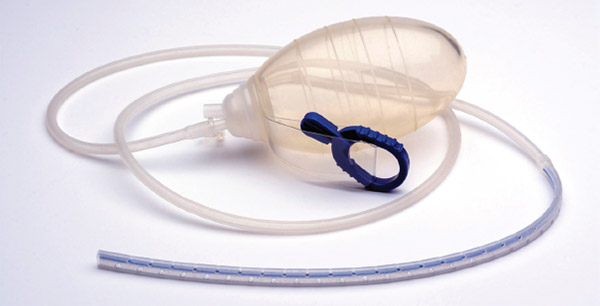Drain care
What is a “drain”?
After your surgery, you will have one or more drains put into the area of your surgical incision (cut).
- The drain should stop fluid from collecting in the surgical area.
- The drain is held in place with 1 or 2 stitches.

A drain will be used to collect fluid from your surgical site.
![]()
What nursing help will I get?
- Your surgeon’s office will make a referral for you to get help with drain care from a nurse.
- A nurse will call you after you leave the hospital.
- A nurse will see you either in your home or at a community clinic.
- The nurse will continue to see you while your drain is in place.
How do I empty my drain?
Emptying the drain means draining fluid out of the container (the bulb) that holds the fluid which comes out of the wound.
- You will empty your drain every 8 hours once you are at home.
- You will be given a Drainage Record sheet in your after-surgery package to help you keep track of the amount of fluid in your drain.
- Write down the amount of fluid that you empty from the drain and the time of day. The Drainage Record sheet will be reviewed by a nurse who will either come to your home or see you at a clinic.
- The fluid will be red at first and then will become pink in colour.
- Over time the fluid will look like the colour of apple juice.
- Small clots of blood or tissue may be seen in the drain – this is normal.
How do I empty the drain?

- Wash your hands with soap and warm water. Dry your hands with a clean towel.
- Take the plug (cap) out of the top of the bulb.
- Empty the drain’s contents into a measuring cup.
- Squeeze all the air out of the bulb.
- Put the plug back in the top of the bulb.
- Once you have recorded the amount, empty the cup’s contents into the toilet to be flushed away.
What if there is no fluid to empty from the drain?
Some of the reasons why there may not be any drainage include:
- The drainage bulb has lost its suction.
- The drainage tubing is blocked.
- There is no more fluid to drain.
To create suction in the bulb, try opening the plug on the bulb and re-closing the plug while squeezing the bulb with your hand.
- The nurses in the hospital will show you how to do this.
How do I "milk the drain?"
To stop the tubing from getting blocked, you will need to "milk the drain."
- "Milking the drain" will clear the tubing of fluid, tissue and clots so that the drain continues to work properly.
- You will need to "milk" the drain every 3 to 4 hours only while you are awake.
- Be sure when "milking" to hold the tube firmly closest to the skin.
- A family member may be able to help you.
When can I expect to have the drain(s) removed?
- You will have the drain(s) for at least 5 days and up to 3 weeks.
- Your drain will come out when the drainage is less than 30 millilitres (just over 2 tablespoons) in 24 hours for 2 days in a row.
- A nurse can remove your drain.
- You may take pain medication 30 to 60 minutes before the drain is removed. This does not usually cause pain.
- You may have a small amount of fluid come out of the hole where the drain entered the body. This will stop in 24 to 48 hours. You can put a small gauze bandage over the hole.






